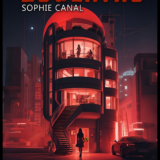
As I sit here tonight it’s snowing up a treat (if you like that kind of thing) in Vancouver, BC, whose weather is usually about the same as San Francisco; i.e., seldom snowy, often wet and/or gloomy, but sometimes gloriously warm and sunny, even in autumn. Figure 1 is the view out my front door tonight (Wednesday, November 29); what looks like a grainy photo is actually a photo of snow. That large white lump under the bare tree near the centre of the picture is the car I drove to the store a couple of hours ago. Oh, well, I guess fall is over and winter has done come, as they say. (Well, somebody’s saying it.) This week I’m wrestling with a number of things (coffee spilled on the keyboard makes it type in interesting ways; my 3D printer’s hotend is leaking liquid filament all over my prints, and so on), so I’m going to rewrite a column from January 2014. I assume most of you weren’t reading it then, so it’ll be new to you.
What I’d like to talk about today is something that many of you may not have seen; and if you have, you might not have really appreciated them. I’m speaking of the old movie serials. Even though, back in The Day—here, I’m speaking of anywhere from the ‘30s to the ‘50s—when a movie would cost a dime or a quarter, the studios and the theatres were afraid that the movie-goers might choose not to go to the theatre. In the ‘30s there was a severe depression, and a dime could buy food instead of frivolity; in the ‘50s there was TV and, even for a quarter, one might choose to stay home instead and watch Jackie Gleason or Lucille Ball. So the theatres began showing two movies for the same entrance fee, as well as a serial and/or a short subject or a newsreel and a cartoon—in colour!—when the other features were in black and white. (Cartoons went colour in about 1931.) Sometimes the theatres would also hold “dish night,” where they gave free dishes to patrons. My mother-in-law, the late Martha “Marty” Taylor, told me her local theatre had live entertainment between movies! As I might have mentioned in an earlier column, the films included a main film—the “A” movie—and a “B” movie, usually made for less money and with less well-known (and therefore cheaper) stars. And since the feature films were changed weekly, some bright person came up with the serial—one chapter weekly—to keep the patrons coming back.

Serials had begun in the silent film era, but reached new popularity in the ‘30s; popular serial genres included the Western—usually the cheapest type to make—featuring comic strip heroes like Red Ryder; the crime serial, often taken from the pages of the comics, with a fantastic hero or villain, like Batman; the “flying” serial, with that most modern of technologies, the airplane; spy serials; and the science-fictional serials like Buck Rogers or Flash Gordon. Other serials came from radio, like the Lone Ranger, or Rin Tin Tin and the like. In order to keep you on the edge of your seat and anxiously awaiting next week’s episode, most serials employed the “cliffhanger,” where the hero or heroine appeared to be in danger of dying just as the episode ends, only to be found alive or rescued at the beginning of the next episode. As mentioned in an earlier column, Stephen King’s antiheroine, Annie Wilkes in Misery, called them “chapter plays,” and claimed that those “cockadoodie cheaters” were dishonest, because clearly, the hero had died at the end of a chapter, only to be alive in the next one. (She was partially right—in many cases the chapter ending shown would have had to result in the hero’s death.) But most people didn’t care, because there were more perils coming up in a few minutes! Serials usually had from 12-16 chapters, with the first chapter sometimes being the longest, so as to establish the characters. (By the way, the lobby cards and posters shown are also a bit dishonest, as the photos were hand-coloured while the serials were all black and white.)

The older serials became popular in the ‘50s, for “kiddie matinees” because a) they were already made, and thus were cheaper for the theatres to rent; and b) because we kids didn’t know any better—to be at the movies was a treat in itself (where you could not only eat your popcorn, you could throw it at the screen! In those days, popcorn was a dime for a big bag or paper box, and not the mainstay of the theatres’ economy as it is today: now, 70% of what you pay to get in goes to the distributor, so the theatre has to make its money on concessions), and we were easily entertained, even by old serials. Today, because most of the serials have fallen into the public domain, you can find them on sale on eBay pretty cheaply, or even downloadable—I assume with torrents. (Aside: because my internet provider, Telus, keeps accusing me of sharing files with bittorrents, I keep my computer scrupulously clean and have no file sharing software at all—for self-protection in case of legal action. Oddly enough, their claims that my computer shared file such-and-such at 2 a.m. on such a date doesn’t seem to take into account that my computer is always shut down between 11 p.m. local time and 6 a.m. And they’ve obviously never heard of IP spoofers. But to continue….)
One eBay seller says this—because eBay requires it—about his serials on DVD: “Thousands of motion pictures are in the Public Domain because they were 1: released without Copyright Notices; 2: were never registered with the Library of Congress, had improper or late registrations; or 3: were not properly renewed under the old requirements for films made before 1964.” The same seller includes not only the serial’s date of release, but also the date it entered public domain, which is smart! (I’ve bought a few, especially Commando Cody in Radar Men From the Moon [1952], because I liked it as a kid.)

My own collection includes about 45 serials of various types—video, MP4, AVI; some have menus and some are just collections of chapters. The first chapter is usually the longest; some are 40 minutes—and the rest are usually fifteen or twenty minutes long. Each chapter pretty much ends the same way: a cliffhanger of sorts where the hero or heroine—going back to Perils of Pauline in the silent film era, there have been plenty of serials with a heroine as the main character, usually portrayed as a reporter (Brenda Starr, for example) or a jungle queen (Perils of Nyoka; retitled Nyoka and the Tigermen, though you won’t find any Tigermen in the serial)—and she is in immediate danger: the car or train is going over a cliff; the airplane has been shot down and there are no parachutes, and so on. Then a quick “Be sure to watch next week for Chapter Blah, Terror in the Night!” or whatever, and then the credits. Next week invariably begins with the last 5 minutes or so of last week’s episode, only sometimes subtly altered or from a different point of view, to show how the hero/heroine escaped certain death. (Those cockadoodie cheaters!) It’s often interesting and amusing to compare last week’s ending with this week’s beginning!
Most SF and fantasy readers are at least somewhat familiar with two of the best-known serials. I refer, of course, to Buck Rogers and Flash Gordon, both starring Clarence L. “Buster” Crabbe. Crabbe was an Olympic swimming gold medalist who, like Johnny Weismuller, parlayed his sports medals and general fitness into a film career. (Interestingly enough, Crabbe started his film career playing Tarzan, which was also Weismuller’s first film role, and Weismuller’s staple role through about 16 films!) Fooled you—this is “Herman Brix” (Bruce Bennett) as Tarzan in The New Adventures of Tarzan, not Crabbe or Weismuller (12 Chapters).

Buster Crabbe starred as Flash Gordon, a character created by Alex Raymond in the comic strips to compete with the established Buck Rogers character—who had originally appeared (as Anthony Rogers) in Philip Nowlan’s Armageddon 2419, first published in Amazing Stories. So Buck Rogers appeared first in print, but Flash Gordon beat him to the movies! As far as I know, there were three Flash Gordon movie serials made: Flash Gordon (1936); Flash Gordon’s Trip to Mars (1938); and Flash Gordon Conquers the Universe (1940). Buck Rogers only had one movie serial, and that was in 1939, called (duh!) Buck Rogers. (Although he is apparently going to have more movies in the future; I understand Frank Miller (The Dark Knight, Sin City) might be going to do at least one.)
These days, it’s easy to laugh at the “special effects” in the nineteen-thirties, but really, special effects stayed pretty constant from Georges Méliès (Le Voyage dans la Lune, 1902) up until the thirties. In-camera tricks, perspective tricks, cardboard scenery and the like, as well as so-called “practical” effects (props, miniatures and replica guns that fired blanks) didn’t start to be replaced by computer graphics until (I believe) Westworld, in 1976. So the “flying flatiron” spaceships were pretty much state of the art for special effects. And it’s perfectly reasonable, given the science of the time, to think there might be people on Saturn. And that everyone wears silly clothes in the future. Now, of course, in the real future, we all wear sensible clothing (as if). And have great CGI effects. Too bad the CGI often overshadows the plot/character thing. Since they had no CGI, the serials were all about plot/character, albeit both were a bit simplified, but given they only had 15 minutes per episode, I think they can be forgiven for that.

As far as the stories go, there’s nothing special in either Flash Gordon or Buck Rogers; you can find descriptions of the plots on Wikipedia; you might even be able to rent one or more on DVD at your local library. I haven’t noticed any showing up on Netflix yet. What I find charming about these serials, all of them, is what we jaded 21st-Century types might think is the naïvité and optimism of the time. In some ways, optimism has been knocked out of our society—at least the part I see every day—not by cynicism, but by practicality and in many cases a kind of world-weary fatalism. The thirties were a time—here I must speak only of the US, because I’m only familiar with that society, even though I wasn’t born then—when a giant Depression was lifting, unemployment was down, a World War and a worldwide deadly flu were all behind us, and technology and medicine were already making strides at improving everyone’s lives. We didn’t know about the coming World War or any of the ills that the last 70 years or so have inflicted upon us; nobody’d ever even heard the terms “global warming” or “climate change”! I’m not arguing, mind you, that we live in a depressing time, just that the thirties seem much livelier and happier in some ways by comparison with today.
Since Buck’s and Flash’s plots and characters are so readily available online, I chose not to go into major detail this week. And remember—Amazing Stories was there, bringing you characters in print that you could see weekly at your favourite theatre!
Comments? Anyone? Bueller? You can comment here or on Facebook, or even by email (stevefah at hotmail dot com). All comments are welcome! (Just be polite, please.) My opinion is, as always, my own, and doesn’t necessarily reflect the views of Amazing Stories or its owner, editor, publisher or other columnists. See you next time!










